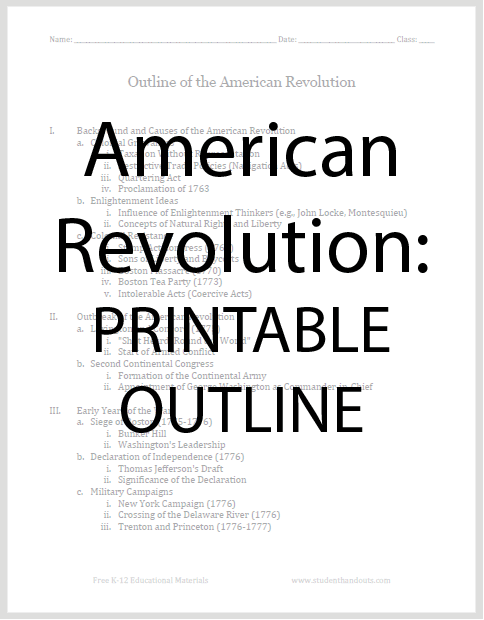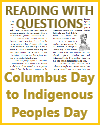| Revolutionary War Printable Outline |
|---|
| studenthandouts.com ↣ U.S. History ↣ Revolutionary War ↣ American Revolution Outlines & PPTs |
 |
    |
|
This outline provides a structured overview of the American Revolution, encompassing its causes, major events, key figures, and the broader implications for the formation of the United States and the development of democratic principles. Students can use this framework to delve deeper into specific aspects of this crucial period in American history. Click here to print. Click here to print an extended version which leaves space for students to take notes (four pages, or two double-sided sheets). |
|
I. Background and Causes of the American Revolution a. Colonial Grievances i. Taxation Without Representation ii. Restrictive Trade Policies (Navigation Acts) iii. Quartering Act iv. Proclamation of 1763 b. Enlightenment Ideas i. Influence of Enlightenment Thinkers (e.g., John Locke, Montesquieu) ii. Concepts of Natural Rights and Liberty c. Colonial Resistance i. Stamp Act Congress (1765) ii. Sons of Liberty and Boycotts iii. Boston Massacre (1770) iv. Boston Tea Party (1773) v. Intolerable Acts (Coercive Acts) II. Outbreak of the American Revolution a. Lexington and Concord (1775) i. "Shot Heard 'Round the World" ii. Start of Armed Conflict b. Second Continental Congress i. Formation of the Continental Army ii. Appointment of George Washington as commander-in-Chief III. Early Years of the War a. Siege of Boston (1775-1776) i. Bunker Hill ii. Washington's Leadership b. Declaration of Independence (1776) i. Thomas Jefferson's Draft ii. Significance of the Declaration c. Military Campaigns i. New York Campaign (1776) ii. Crossing of the Delaware River (1776) iii. Trenton and Princeton (1776-1777) IV. Foreign Involvement and Turning Points a. Saratoga (1777) i. American Victory ii. Alliance with France (Treaty of Alliance, 1778) b. Winter at Valley Forge (1777-1778) i. Challenges and Training ii. Baron von Steuben's Influence c. The Southern Campaign i. British Strategy in the South ii. Battles of Cowpens and Guilford Courthouse (1781) V. End of the War and Treaty of Paris a. Siege of Yorktown (1781) i. combined American and French Assault ii. Cornwallis Surrenders b. Treaty of Paris (1783) i. Recognition of American Independence ii. Borders and Territories Defined VI. Aftermath and Legacy of the American Revolution a. Creation of the United States Constitution (1787) i. Constitutional Convention ii. Ratification and Bill of Rights (1791) b. Formation of Political Parties (Federalists vs. Anti-Federalists) i. Federalist Papers ii. Emergence of Thomas Jefferson and Alexander Hamilton c. Influence on Other Revolutions (e.g., French Revolution) i. Spread of Revolutionary Ideas d. Long-Term Impact on American Identity and Democracy i. Concepts of Liberty, Equality, and Democracy e. Historical Significance and commemoration i. The American Revolution as a Founding Moment |
| studenthandouts.com ↣ U.S. History ↣ Revolutionary War ↣ American Revolution Outlines & PPTs |








